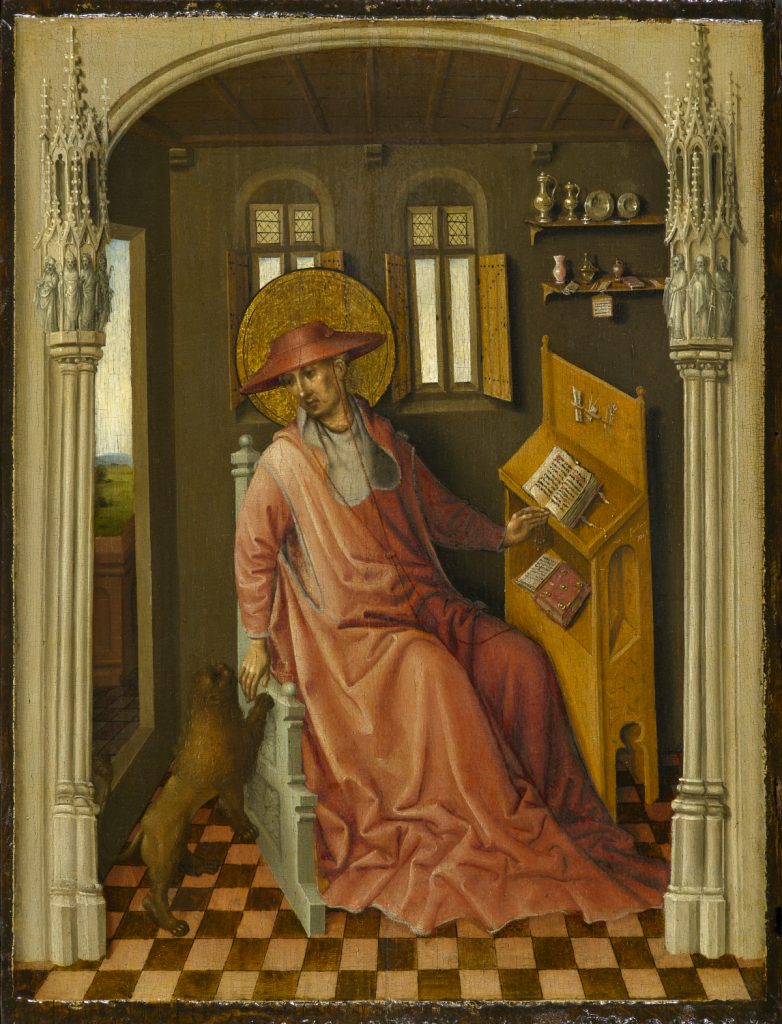St. Jerome in His Study (work of art)
Artwork Info
Key Ideas
- St. Jerome is portrayed sitting at a desk in his wood-paneled study. He is best known for translating the Hebrew and Greek text of the Bible to Latin. His Latin translation is known as the Vulgate.
- The animal standing on its hind legs is a lion, which is considered to be a symbol of St. Jerome. The artist most likely had never seen a lion, so the depiction of the animal isn’t very realistic. According to legend, St. Jerome once met a lion with a thorn in its paw and took pity on it. He removed the thorn for the suffering animal, who became his devoted companion.
- In this painting St. Jerome is dressed in the red robes that are often worn by Catholic cardinals, high-ranking officials in the Catholic church.
- Artist Stefan Lochner was one of the most important German painters of the late Gothic time period. He painted many religious subjects and developed a unique style by combining realism with the more popular style of depicting figures with long flowing lines. This style was new to the iconography, or traditional images or symbols associated with a subject, of the early Northern Renaissance.
Learn More
St. Jerome (circa 332–420) is known for his translation of the Bible from Hebrew and Greek into Latin, called the Vulgate. Because he once served as secretary to the pope in Rome, St. Jerome is depicted wearing the red hat and robes of a cardinal (even though that church office did not exist during his lifetime). He is portrayed in this painting as a scholar who is seated in a wood-paneled study with a tile floor. The linear perspective of the painting creates the illusion of depth. The portrait is framed by a stone archway and pillars carved with figures of saints under Gothic canopies, and St. Jerome is looking at a small animal that is standing on its hind legs beside him. According to legend, during a visit to the wilderness near Bethlehem, St. Jerome met a lion that had a thorn in its paw. He took pity on the lion and removed the thorn, and the lion became his devoted companion. The artist probably had never seen a lion and modeled his depiction based on other artists’ portrayals of lions.
Lochner’s attention to details such as the books and writing tools on the desk, the pewter containers on the shelves, and the angled folds of fabric over St. Jerome’s feet are characteristic of many northern European paintings from this time period. The artist’s interest in the natural world is reflected in the landscape depicted beyond the open door.
tags: late Gothic, northern Renaissance, Netherlandish painting
Additional Resources
Resources for Teachers:
- Read an article about the life and work of St. Jerome.
- Explore the Vulgate, St. Jerome’s most notable achievement.
- Learn about artist Stefan Lochner and view other paintings he created.
Resources for Students:
- Take an interactive tour of the NCMA conservation lab and see the changes the artist made to this painting while he was creating it.
- Explore a similar painting by another influential German painter.
- Explore Vatican City, home of the pope and the smallest country in the world.

